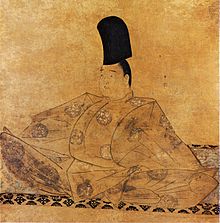Emperor Go-Toba
| Go-Toba | |
|---|---|
| Emperor of Japan | |
 | |
| Reign | 1183-1198 |
| Predecessor | Antoku |
| Successor | Tsuchimikado |
| Born | 6 August 1180 Heian Kyō |
| Died | 28 March 1239 Oki Island |
| Burial | Ōhara no Misasagi (大原陵) (Kyoto) |
| Father | Takakura |
Emperor Go-Toba (後鳥羽天皇, Go-Toba-tennō, 6 August 1180-28 March 1239) was the 82nd emperor of Japan, according to the traditional order of succession.[1] His reign started in 1183 and ended in 1198.[2]
This 12th century sovereign was named after Emperor Toba and go- (後) means "later". He is sometimes called the later Emperor Toba. In some older sources, this emperor may be identified as "Toba the Second" or as "Toba II".
Traditional history[change | change source]
Before he became the monarch, his personal name (imina) was Takahira-shinnō (尊成親王),[3] or Takanari-shinnō[4]
He was the fourth son of Emperor Takakura.[4]
Events of Go-Toba's life[change | change source]
Go-Toba was placed on the throne at the age of three.
- 8 September 1183 (Juei 2, 20th day of the 8th month): In the 3rd year of Antoku-tennō 's reign, the emperor and his court fled the capital. In the emperor's absence, former-Emperor Go-Shirakawa made Antoku's younger brother emperor by decree. A ceremony which marked the young prince's acceptance of the abdication (juzen).[5]
- 1184' (Juei 3): Emperor Go-Toba is said to have accepted the monarch's role and duties and powers (sokui).[4] This was confirmed in ceremonies.[6]
- 1192 (Kenkyū 3): Go-Shirakawa died.[7] Go-Toba was the grandson of Emperor Go-Shirakawa.
- 1198 (Kenkyū 9): In the 15th year of Go-Toba's reign, he abdicated. His successor was his eldest son who became known as Emperor Tsuchimikado.[8]
- 1210 (Jōgen 4): Go-Toba's 3rd son was named emperor; and he became known as Emperor Juntoku.[9]
- 1221 (Jōkyū 3): Go-Toba and his supporters tried and failed to take power from the Kamakura shogunate. This was known as the Jōkyū War (Jōkyū no hen)[10] Go-Toba was exiled to the Oki Islands where he stayed until his death.[11]
- 13 May 1221 (Jōkyū 3, 20th day of the 4th month): Go-Toba's 4-year-old grandson was made emperor; and he became known as Emperor Chūkyō.[12]
- 14 January 1222 (Jōkyū 3, 1st day of the 12th month): Go-Toba's nephew was made emperor; and he became known as Emperor Go-Horikawa.[13]
- 1239 (En'ō 1, 2nd month): Go-Toba died at age 60.[14]
After his death[change | change source]
Go-Toba was buried on Dōgo Island in the Oki Islands group. Later a part of his body was re-buried in Kyoto.[15]
According to the Imperial Household Agency, the mausoleum (misasagi) of Go-Toba is in Kyoto. The emperor is traditionally venerated at a memorial Shinto shrine at Ōhara no Misasagi.[1]
Eras of Go-Toba's reign[change | change source]
The years of Go-Toba's reign are marked by more than one era name:.[2]
Related pages[change | change source]
References[change | change source]

- ↑ 1.0 1.1 Imperial Household Agency (Kunaichō), 後鳥羽天皇 (82); retrieved 2011-12-20.
- ↑ 2.0 2.1 Klaproth, Julius von (1834). Nipon o dai itsi ran: ou Annales des empereurs du Japon. Oriental Translation Fund. pp. 207–221.
- ↑ Varley, p. 215.
- ↑ 4.0 4.1 4.2 Klaproth, Julius von (1834). Nipon o dai itsi ran: ou Annales des empereurs du Japon. Oriental Translation Fund. p. 207.
- ↑ Varley, p. 216.
- ↑ Varley, p. 44; a distinct act of senso is unrecognized prior to Emperor Tenji; and all sovereigns except Jitō, Yōzei, Go-Toba, and Fushimi have senso and sokui in the same year until the reign of Emperor Go-Murakami. Compare Imperial Household Agency (Kunaichō), Ceremony of Accession (Sokui-no-Rei); retrieved 2011-12-23.
- ↑ Klaproth, Julius von (1834). Nipon o dai itsi ran: ou Annales des empereurs du Japon. Oriental Translation Fund. p. 219.
- ↑ Klaproth, Julius von (1834). Nipon o dai itsi ran: ou Annales des empereurs du Japon. Oriental Translation Fund. p. 221.
- ↑ Klaproth, Julius von (1834). Nipon o dai itsi ran: ou Annales des empereurs du Japon. Oriental Translation Fund. p. 230.
- ↑ Nussbaum, Louis-Frédéric (2002). Japan Encyclopedia. Harvard University Press. p. 431. ISBN 978-0-674-01753-5.
- ↑ Mason, R.H.P. Mason and J.G. Caiger. (1972). A History of Japan, p. 105.
- ↑ Klaproth, Julius von (1834). Nipon o dai itsi ran: ou Annales des empereurs du Japon. Oriental Translation Fund. p. 236.
- ↑ Klaproth, Julius von (1834). Nipon o dai itsi ran: ou Annales des empereurs du Japon. Oriental Translation Fund. p. 238.
- ↑ Klaproth, Julius von (1834). Nipon o dai itsi ran: ou Annales des empereurs du Japon. Oriental Translation Fund. p. 244.
- ↑ Brownlee, John S. (1991). Political Thought in Japanese Historical Writing: From Kojiki (712) to Tokushi Yoron (1712). Wilfrid Laurier University Press. p. 104. ISBN 978-0-88920-997-8.
Other websites[change | change source]
![]() Media related to Emperor Go-Toba at Wikimedia Commons
Media related to Emperor Go-Toba at Wikimedia Commons
| Preceded by Emperor Antoku |
Emperor of Japan: Go-Toba 1183-1198 |
Succeeded by Emperor Tsuchimikado |
